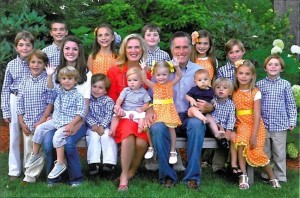Two Surefire Solutions to Inequality
Here is a surefire solution to inequality–Increase fertility among the rich. If the rich had more children, capital would grow more slowly across the generations and perhaps not at all. If r=4 and g=2 then capital doubles as a share of the economy in 35 years (using the rule of 70). That figure is actually too low as it assumes that the wealthy save all of their capital income but let’s stick with 35 years and call that a generation. Wealth per rich person, however, only doubles if every wealthy family has just 2 children. If every wealthy family has 4 children, wealth per person doesn’t increase and so inequality does not increase even when r>g. If the wealthy consume about 20% of their capital income (still a very high savings rate) and have just 3 children then again we have approximate balance and no increase in inequality over the generations. With a more reasonable figure on r-g or with more children, wealth per person actually declines.
Thus, Piketty’s “patrimonial capital” contains its own internal contradiction. The more patrimony the less capital.
 So how can we increase fertility among the rich? Mormon fertility is higher than average so capital inequality could decline if more rich people will be or become Mormons. Had we elected a President Romney (5 children and some 22 grandchildren! Or is it 23? Romney has lost count), perhaps that would have encouraged greater fertility among the rich.
So how can we increase fertility among the rich? Mormon fertility is higher than average so capital inequality could decline if more rich people will be or become Mormons. Had we elected a President Romney (5 children and some 22 grandchildren! Or is it 23? Romney has lost count), perhaps that would have encouraged greater fertility among the rich.
It’s an evolutionary puzzle why the rich don’t have more children as the costs to them are low and at very high levels of wealth there is no quantity-quality tradeoff. Perhaps this is a temporary response to the shock of birth control. If so, the effect of the shock is likely to fade over time as evolution works its logic.
In Selfish Reasons to Have More Kids Bryan Caplan notes that we overestimate the effect of parental investment on children and we underestimate the pleasures of grandchildren, in both cases choosing too few children. The rich should read Bryan’s book.
In these calculations I have assumed that primogeniture won’t make a comeback, that seems solid. Assortative mating, however, will slow wealth dispersion. I have also assumed that savings and fertility are independent which is unlikely to be the case. Becker and Barro (1988) suggest that more children will increase savings but less than proportionally so the logic continues to hold. Note also that this works both ways, wealthy people with fewer children will save less. Bill Gates has three children but has already given away a substantial fraction of his fortune and he has pledged to give away much more. Even parental altruism has its limits and Bill Gates has decided that on the margin he would rather give money to poor children in Africa than to his own children. Bill Gates’s shadow will not eat our future.
So what is the second surefire method to reduce capital inequality? Reduce fertility among the rich! If the rich as a class have fewer than 2 children then it follows inexorably that their time is numbered, albeit without first creating a small number of very rich people.
The logic of r-g turns out to be highly dependent on savings behavior, fertility decisions and the nature of altruistic bequests.